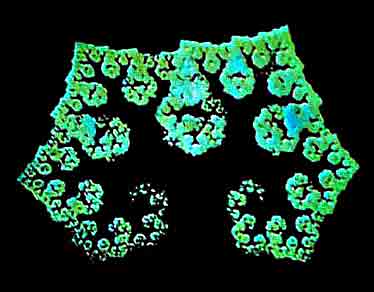FeedbackVideo FeedbackFinally, we will examine a fun, easy way to use feedback to make fractal patterns without a computer. This is easy to do with only a video camera and a TV. In the simplest form of video feedback, you take the camera and run a cable carrying the live image into the TV. then you point the camera at the monitor, so you're taking a picture of the TV screen, which then shows up on the screen. This image keeps looping around creating a dazzling array of shapes. Video feedback is very sensitive, and you will get the best results by using a tripod. The zoom distance is critical. If you'r zoomed out too far, you'll just see a tunnel of nested images. If you zoom in too close, the screen breaks up into chaos. Right at the edge of chaos is where the most interesting patterns emerge. You can also play with the angle of the camera. If you rotate it 90 degrees, you'll see a square tunnel, where the image returns to the original orientation every 4 cycles. If you rotate the camera 120 degrees, you'll see a triangular tunnel, where it repeats every 3 cycles. In between these simple periodic patterns, you'll find higher-order periods, much like the the periodicities in the Mandelbrot Set.
The images below were made using a camera and two monitors, and they are some of the most fractal-like examples of video feedback. Many of them closely resemble geometric fractals
such as the Iterated Function Systems from Chapter 2.
|
||||||||||||||||||||||||||||||
|
<- PREVIOUS NEXT -> © Fractal Foundation. |
||||||||||||||||||||||||||||||



















